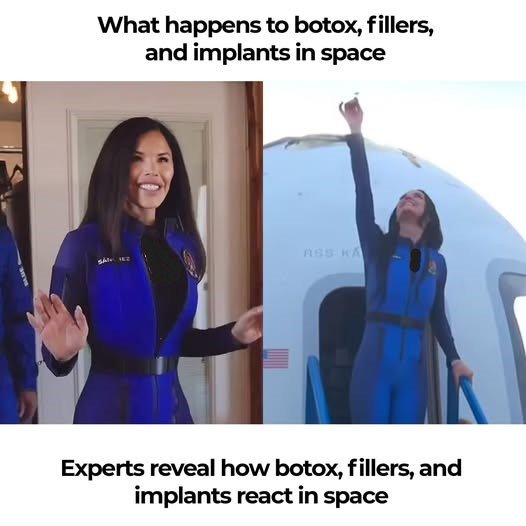With space tourism on the rise, a new question arises: how do cosmetic enhancements like Botox, fillers, and implants react to the extreme conditions of space
Lauren Sánchez, Katy Perry, and the All-Female space crew
On Monday morning, Lauren Sánchez, Jeff Bezos’ fiancée, embarked on a historic all-female mission aboard Blue Origin’s New Shepard rocket.
She was joined by pop star Katy Perry, CBS co-host Gayle King, and other crewmates.
The flight marked the first all-female crew to venture into space.
While, some people are raising questions about the need for such an expensive and glamorous mission.
One area of curiosity is how Sánchez’s alleged cosmetic enhancements, such as Botox and breast implants, would hold up under extreme conditions.
Concerns about cosmetic procedures in space
Though Sánchez has never confirmed the rumors, she is speculated to have undergone Botox, lip fillers, and even a facelift.
Given the intense conditions of space travel, experts have weighed in on how these enhancements might react.
Dr. Stanton Gerson, a researcher who studies the effects of deep space on human cells, raised concerns about the extreme stresses of rocket launches.
At speeds of 6,000 mph, forces can cause “shear stress,” which may affect implanted materials like breast implants or dermal fillers.
The impact of hight altitudes and rocket lauch on implants
A study by Yale University in 2013 found that women with breast implants sometimes experience discomfort during flights at high altitudes. This is caused by pressure changes that lead to the accumulation of “peri-implant gas.”
However, modern implants with cohesive gels are less likely to face these issues.
Even so, the intense forces during a rocket launch and re-entry could still cause some discomfort.
Although breast implants may be affected by pressure changes, modern versions are less vulnerable to this problem.
How botox and fillers respond to zero gravity
In zero gravity, bodily fluids shift toward the head, which could lead to puffiness or alter the appearance of dermal fillers and Botox.
However, cosmetic surgeons believe these changes would be minimal during a brief spaceflight.
Dr. Giselle Prado-Wright, a cosmetic surgeon, explained that dermal fillers, made from stable hyaluronic acid, integrate into the tissue over time.
“Once healed, they move and behave just like your own soft tissue,” she said. As a result, no significant changes are expected.
As space tourism evolves, questions arise about how cosmetic procedures might fare in space.
The all-female crew, which included Sánchez and Perry, appeared in full makeup, with Sánchez even securing her fake lashes to prevent them from flying off during liftoff.
Katy Perry, known for her glamorous image, even joked before the trip, “Space is going to finally be glam.”
She explained that she would take her glam up with her if possible, stating, “We are going to put the ‘ass’ in astronaut.”
Criticsm and debate on glam and space tourism
The all-female crew’s “glam” approach drew mixed reactions.
Actress Olivia Munn, on an episode of Today With Jenna and Friends, questioned the mission’s scientific value and the need for makeup in space.
“What? They said this out loud?” Munn exclaimed when learning that the crew would travel with their hair and makeup done.
Despite the criticism, some argue that space tourism offers a unique opportunity for research.
It allows scientists to observe how cosmetic enhancements like Botox and fillers fare in extreme conditions.
“We have no idea what might happen,” Dr. Gerson admitted.



